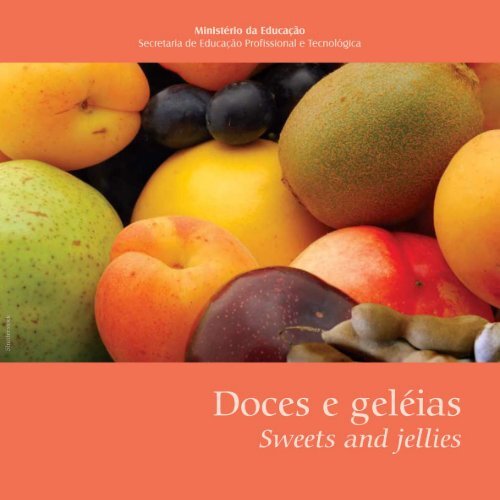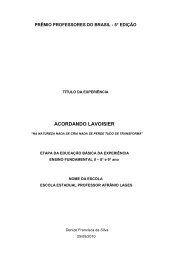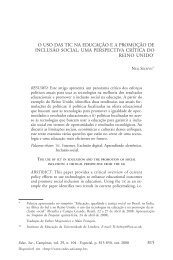Doces e geléias - Portal do Professor - Ministério da Educação
Doces e geléias - Portal do Professor - Ministério da Educação
Doces e geléias - Portal do Professor - Ministério da Educação
You also want an ePaper? Increase the reach of your titles
YUMPU automatically turns print PDFs into web optimized ePapers that Google loves.
<strong>Doces</strong> e <strong>geléias</strong> sweets and jellies<br />
<strong>Ministério</strong> <strong>da</strong> <strong>Educação</strong><br />
Ministry of Education<br />
Secretaria de <strong>Educação</strong> Profissional e Tecnológica<br />
Professional and Technological Education Secretariat<br />
Brasília, novembro de 2007<br />
Brasília, November 2007<br />
<strong>Doces</strong> e<br />
<strong>geléias</strong><br />
Sweets and jellies
Shutterstock<br />
2 Cartilhas Temáticas Thematic Pamphlets
<strong>Doces</strong> e <strong>geléias</strong> sweets and jellies<br />
Apresentação / Presentation<br />
Com entusiasmo, a Secretaria de<br />
<strong>Educação</strong> Profissional e Tecnológica<br />
(Setec) publica, em 2007, mais<br />
quatro cartilhas temáticas. Cria<strong>da</strong>s há<br />
<strong>do</strong>is anos para apresentar os resulta<strong>do</strong>s<br />
<strong>da</strong> articulação <strong>da</strong> política de formação de<br />
trabalha<strong>do</strong>res <strong>do</strong> <strong>Ministério</strong> <strong>da</strong> <strong>Educação</strong><br />
com as ações empreendi<strong>da</strong>s por setores<br />
produtivos locais, esses volumes mostram<br />
alguns aspectos <strong>do</strong> trabalho realiza<strong>do</strong> por<br />
escolas <strong>da</strong> rede federal em colaboração com<br />
empreende<strong>do</strong>res brasileiros.<br />
As experiências mostra<strong>da</strong>s nesses volumes<br />
– relaciona<strong>da</strong>s à cultura <strong>do</strong> cupuaçu, à<br />
produção de <strong>do</strong>ces e <strong>geléias</strong>, à criação de<br />
ovelhas e cabras e à cadeia produtiva de<br />
rochas ornamentais – resultam <strong>da</strong>s políticas<br />
de educação, geração de trabalho e ren<strong>da</strong> <strong>do</strong><br />
Governo Federal destina<strong>da</strong>s a combater as<br />
profun<strong>da</strong>s desigual<strong>da</strong>des sociais brasileiras.<br />
Os textos aqui apresenta<strong>do</strong>s mostram<br />
um pouco <strong>da</strong> história <strong>do</strong> país, os cursos<br />
ofereci<strong>do</strong>s pelas escolas federais de educação<br />
profissional e também as pesquisas setoriais<br />
desenvolvi<strong>da</strong>s por pesquisa<strong>do</strong>res brasileiros.<br />
Há, em alguns deles, ain<strong>da</strong>, receitas pitorescas<br />
ou populares. Esperamos que tenham, ao<br />
lê-los, a mesma satisfação e orgulho que os<br />
gestores <strong>da</strong> Secretaria de <strong>Educação</strong> Profissional<br />
e Tecnológica tiveram ao decidir publicá-los.<br />
Setec/MEC<br />
In 2007, the Professional and Technical Education Secretariat (Setec) takes pleasure in publishing four more thematic<br />
informative bulletins. Created two years ago to present the results of the workers training policies developed by<br />
the Ministry of Education together with actions undertaken by local productive sectors, these volumes show some<br />
of the aspects of the work carried out by federally funded schools in collaboration with Brazilian entrepreneurs.<br />
The experiences shown in these volumes - related to cupuaçu crops, the production of sweets and jellies,<br />
raising sheep and goats and the production chain of ornamental rocks - are the result of education, jobs and<br />
income policies of the federal government to combat the profound social inequalities in Brazil.<br />
The texts presented here show some of our country’s history, the courses offered by federal professional<br />
schools and also the work in these areas by Brazilian researchers. Some of them even have unique and popular<br />
recipes. We hope that after reading them you will feel the same satisfaction and pride felt by the managers at<br />
the Professional and Technical Education Secretariat when they decided to publish them.<br />
Setec/MEC
Cartilhas Temáticas Thematic Pamphlets<br />
O nosso <strong>do</strong>ce de ca<strong>da</strong> dia<br />
Tradição começou com coloniza<strong>do</strong>r português que,<br />
junto com mu<strong>da</strong>s de cana-de-açúcar, também trouxe o hábito<br />
Os <strong>do</strong>ces e <strong>geléias</strong> de frutas estão presentes em to<strong>do</strong>s os esta<strong>do</strong>s e fazem parte <strong>do</strong> dia-a-dia<br />
<strong>do</strong>s brasileiros. A tradição nasceu com o coloniza<strong>do</strong>r português que, junto com as primeiras<br />
mu<strong>da</strong>s de cana-de-açúcar, também trouxe o hábito de comer <strong>do</strong>ce. Nas cozinhas <strong>da</strong>s casasgrandes<br />
<strong>da</strong>s fazen<strong>da</strong>s produtoras de açúcar, as senhoras iam ensinan<strong>do</strong> as escravas a misturar<br />
corretamente os ingredientes. Com a fartura <strong>do</strong> açúcar e a varie<strong>da</strong>de de frutas existentes, as<br />
culturas foram se misturan<strong>do</strong> e novos <strong>do</strong>ces foram surgin<strong>do</strong> <strong>do</strong>s tachos. A estrutura culinária<br />
foi manti<strong>da</strong>, mas os ingredientes, troca<strong>do</strong>s, pois as frutas existentes em Portugal eram<br />
substituí<strong>da</strong>s pelas disponíveis na colônia.<br />
João Luís Almei<strong>da</strong> Macha<strong>do</strong>, professor de História de Gastronomia, <strong>do</strong> Serviço Nacional <strong>do</strong><br />
Comércio (Senac) de São Paulo, e mestre em <strong>Educação</strong>, Arte e História <strong>da</strong> Cultura, relata que<br />
com o crescimento <strong>da</strong> comercialização <strong>do</strong> açúcar no merca<strong>do</strong> interno, incrementa<strong>do</strong> com a chega<strong>da</strong><br />
de Dom João VI ao Brasil, as receitas portuguesas foram se espalhan<strong>do</strong> por to<strong>da</strong> a colônia<br />
e passan<strong>do</strong> a fazer parte <strong>do</strong> cardápio alimentar. “Os <strong>do</strong>ces integraram-se de tal forma à cultura<br />
brasileira que passaram a representar nossos mais íntimos sentimentos em relação aos amores de<br />
nossas vi<strong>da</strong>s, carinhosamente chama<strong>do</strong>s por alcunhas como ‘<strong>do</strong>ce de coco’, ‘manjar’, ‘<strong>do</strong>cinho’<br />
ou a referências como ‘ela é um <strong>do</strong>ce de pessoa’”, pontua.
Our Daily Sweets<br />
The tradition began with the<br />
Portuguese colonizers and the<br />
sugarcane they brought with them<br />
Fruit jellies and sweets are present in all<br />
Brazilian states and are part of the people’s <strong>da</strong>ily<br />
lives. The tradition began with the Portuguese<br />
colonizers, who brought the first sugarcane plants,<br />
and also brought the habit of eating sweets. In<br />
the kitchens of the plantation houses, the wives<br />
would teach the slaves how to correctly mix the<br />
ingredients. With the abun<strong>da</strong>nce of sugar and<br />
the variety of fruits available, different cultures<br />
mixed and new sweets were invented. The culinary<br />
structure was maintained but the ingredients were<br />
changed since the fruits available in Portugal were<br />
replaced by those available in the Brazilian colony.<br />
João Luís Almei<strong>da</strong> Macha<strong>do</strong>, professor of<br />
gastronomical history for the National Commercial<br />
Training Service (Senac) in São Paulo, who holds<br />
a master’s degree in education, art and cultural<br />
history, says that with the increased sugar trade in<br />
the Brazilian <strong>do</strong>mestic market that began with the<br />
arrival of Dom João VI in Brazil, Portuguese recipes<br />
were spread throughout the colony and became<br />
part of Brazilian eating habits. “Sweets became so<br />
integrated into Brazilian culture that they began to<br />
represent our most intimate feelings in relation to<br />
the loves of our lives, tenderly called by names like<br />
“sweetheart”, “sweetie” or references like “she’s<br />
so sweet,” he points out.<br />
<strong>Doces</strong> e <strong>geléias</strong> sweets and jellies<br />
Shutterstock
Cartilhas Temáticas Thematic Pamphlets
<strong>Doces</strong> e <strong>geléias</strong> sweets and jellies<br />
Nos livros de história <strong>da</strong> gastronomia brasileira não há registro exato <strong>do</strong> perío<strong>do</strong> em que<br />
essas compotas deixaram de ser feitas unicamente para o consumo <strong>da</strong>s famílias <strong>do</strong>s senhores<br />
de engenho e passaram a ser comercializa<strong>da</strong>s, mas as primeiras iniciativas remontam à época<br />
<strong>do</strong> Império. “Nas principais ci<strong>da</strong>des brasileiras, como Rio de Janeiro ou Salva<strong>do</strong>r, negras<br />
escravas podiam ser vistas venden<strong>do</strong> <strong>do</strong>ces e bolos tradicionais, feitos com frutas típicas ou<br />
bem a<strong>da</strong>pta<strong>da</strong>s ao nosso país, como a goiaba ou a banana”, estima João Luís Almei<strong>da</strong>.<br />
Hoje, <strong>do</strong>ces e <strong>geléias</strong> feitos com frutos típicos de ca<strong>da</strong> região são encontra<strong>do</strong>s tanto nas<br />
grandes capitais quanto nos pequenos municípios. Porém, como na época <strong>do</strong> Império, muitas<br />
varie<strong>da</strong>des sequer são conheci<strong>da</strong>s nacionalmente. Por outro la<strong>do</strong>, a diversi<strong>da</strong>de <strong>da</strong>s frutas<br />
existentes com proprie<strong>da</strong>des adequa<strong>da</strong>s para o processamento desses produtos demonstra que<br />
este é um merca<strong>do</strong> que tem potencial para crescer.<br />
In books on Brazilian gastronomical history<br />
there is no exact record of the period when<br />
these compotes were no longer solely for the<br />
consumption of the families of sugar planters<br />
and began to be marketed, but the first<br />
initiatives go back to the time of the Brazilian<br />
empire. “In the main Brazilian cities such as Rio<br />
de Janeiro or Salva<strong>do</strong>r, slaves could be seen<br />
selling traditional sweets and cakes made<br />
from native fruits or those well a<strong>da</strong>pted<br />
to our country, such as guavas and<br />
bananas,” says João Luiz Almei<strong>da</strong>.<br />
To<strong>da</strong>y, jellies and sweets made<br />
from local fruits from each region<br />
are found in both large cities as<br />
well as small towns. However,<br />
as in the time of the empire, many varieties are<br />
not known nationally. On the other hand, the<br />
diversity of fruits with properties appropriate for<br />
making these products demonstrates<br />
that this is a market with<br />
growth potential.<br />
7<br />
Shutterstock
Cartilhas Temáticas Thematic Pamphlets<br />
Brasil em compotas<br />
Que tal um <strong>do</strong>ce? Após as refeições, principalmente a <strong>do</strong> meio-dia, essa é uma pergunta<br />
comum de Norte a Sul <strong>do</strong> Brasil. Há mu<strong>da</strong>nças de sabor, cor e textura, mas o hábito faz parte<br />
<strong>da</strong> cultura gastronômica e é responsável pela geração de mais de 30 mil empregos formais e<br />
informais. De acor<strong>do</strong> com a Associação Brasileira <strong>da</strong> Indústria de Alimentação (Abia), as 550<br />
empresas registra<strong>da</strong>s em 2005 estavam distribuí<strong>da</strong>s em 25 esta<strong>do</strong>s e geravam mais de 15 mil<br />
empregos. Outra característica dessa ativi<strong>da</strong>de é a presença marcante <strong>da</strong>s pequenas empresas.<br />
Do total <strong>do</strong>s estabelecimentos formalmente registra<strong>do</strong>s, 457, ou seja, 83% <strong>do</strong> total, são<br />
de pequeno porte. “Esse é um merca<strong>do</strong> tradicional, que<br />
registra um crescimento de 6% a 8% ao ano e conta com<br />
a participação significativa de pequenos comerciantes”,<br />
analisa Denis Ribeiro, coordena<strong>do</strong>r <strong>do</strong> departamento de<br />
economia <strong>da</strong> Abia.<br />
No que diz respeito à produção <strong>da</strong>s cooperativas, associações<br />
e iniciativas individuais, estu<strong>do</strong> realiza<strong>do</strong> pela<br />
Secretaria Nacional de Economia Solidária, <strong>do</strong> <strong>Ministério</strong><br />
<strong>do</strong> Trabalho e Emprego (MTE), com <strong>da</strong><strong>do</strong>s de 2005 a 2007,<br />
constatou a existência de 585 empreendimentos solidários,<br />
distribuí<strong>do</strong>s em mais de 300 ci<strong>da</strong>des <strong>do</strong>s 27 esta<strong>do</strong>s.<br />
A ativi<strong>da</strong>de garante ocupação para 18.573 pessoas, e a<br />
comercialização contabiliza faturamento anual de mais<br />
de R$ 25 milhões. “Em primeiro lugar, vale destacar que<br />
o processamento e produção de alimentos e bebi<strong>da</strong>s é a<br />
segun<strong>da</strong> maior ativi<strong>da</strong>de <strong>da</strong> economia solidária e representa<br />
o segun<strong>do</strong> maior faturamento”, atesta o diretor<br />
<strong>do</strong> Departamento de Estu<strong>do</strong>s e Divulgação, <strong>do</strong> Sistema<br />
de Informações em Economia Solidária (SIES), <strong>do</strong> MTE,<br />
Roberto Marinho Alves.
Brazil in<br />
Compotes<br />
How about dessert?<br />
After meals, especially<br />
at noontime, this is<br />
a common question<br />
throughout Brazil. There<br />
are all kinds of flavors,<br />
colors and textures, but<br />
the custom is part of our<br />
gastronomical culture<br />
and is responsible for<br />
creating more than 30,000<br />
formal and informal jobs.<br />
According to the Brazilian<br />
Food Industry Association<br />
(Abia), the 500 companies<br />
registered in 2005 were<br />
distributed among 25<br />
states and created more<br />
than 15,000 jobs. Another<br />
characteristic of this activity is the remarkable<br />
number of small businesses. Of all establishments<br />
formally registered, 457 or 83% of them are small<br />
businesses. “This is a traditional market that grows<br />
between 6-8% annually and has a significant<br />
number of small entrepreneurs,” says Denis Ribeiro,<br />
coordinator of the Abia economic department.<br />
Regarding production by cooperatives,<br />
associations and individual entrepreneurs, a<br />
study conducted by the National Collaborative<br />
Economy Secretariat, part of the Ministry of Labor<br />
and Employment (MTE), from the <strong>da</strong>ta covering<br />
<strong>Doces</strong> e <strong>geléias</strong> sweets and jellies<br />
2005-2007 it was determined that there are 586<br />
cooperative enterprises distributed among more<br />
than 300 cities in 27 states. The activities provide<br />
employment for 18,573 people and the businesses<br />
generate total revenues of more than R$ 25 million.<br />
“First we should emphasize that food and beverage<br />
processing and production is the second largest<br />
cooperative economic activity and represents<br />
the second highest earnings,” declares Roberto<br />
Marinho Alves, director of the Studies and Diffusion<br />
Department of the Collaborate Economy Information<br />
System (SIES) of the MTE.
0 Cartilhas Temáticas Thematic Pamphlets<br />
Além de gerar trabalho, ele pontua que a ativi<strong>da</strong>de contribui para a inclusão social e a<br />
complementação <strong>do</strong> orçamento familiar. “As mulheres são as que mais estão envolvi<strong>da</strong>s nessa<br />
ativi<strong>da</strong>de. Isso tem um significa<strong>do</strong> importante para a melhoria <strong>da</strong> quali<strong>da</strong>de de vi<strong>da</strong> dessas<br />
famílias”, ressalta. Marinho destaca ain<strong>da</strong> que o número total de empreendimentos solidários<br />
levanta<strong>do</strong> pelo ministério ain<strong>da</strong> não representa a totali<strong>da</strong>de <strong>da</strong>s iniciativas existentes no setor.<br />
“Nesses <strong>da</strong><strong>do</strong>s só estão contabiliza<strong>do</strong>s os empreende<strong>do</strong>res que informaram o faturamento<br />
mensal em 2005. Estimamos que o número seja duas vezes maior”, destaca.<br />
Priscilla Rocha Silva, engenheira agrônoma <strong>do</strong> Instituto de Economia Agrícola (IEA) de São Paulo,<br />
avalia que o setor está crescen<strong>do</strong>, principalmente na informali<strong>da</strong>de. “Muitos homens e mulheres<br />
estão trabalhan<strong>do</strong> no processamento de frutas para gerar ren<strong>da</strong>. Alguns estão organiza<strong>do</strong>s em<br />
cooperativas e associações e outros produzem individualmente”, pontua. Para ela, um <strong>do</strong>s desafios<br />
para incrementar o crescimento é a oferta de capacitação e o estímulo à produção de frutas.<br />
Empregos gera<strong>do</strong>s / Jobs created<br />
Regiões / State Formais / Formals Coopera<strong>do</strong>s / Cooperative<br />
Norte 859 3.056<br />
Nordeste 6.376 8.227<br />
Centro-Oeste 98 1.743<br />
Sul 3.514 2.563<br />
Sudeste 4.903 2.984<br />
Total / Total 15.750 18.573<br />
Fonte Empresas: <strong>Ministério</strong> <strong>do</strong> Trabalho e Emprego, segun<strong>do</strong> a RAIS (Relação Anual de Informações Sociais), (em<br />
31/12/2005). Elaboração ABIA, segun<strong>do</strong> critério Sebrae: 0 a 19 emprega<strong>do</strong>s (micro), de 20 a 99 (pequena), de 100 a<br />
499 (média), mais de 500 (grande). / Source for Companies: Ministry of Labor and Employment, according to the RAIS<br />
(Annual Social Information Report of 12/31/2005), prepared by ABIA according to Sebrae criteria: from 0 to 19 employees<br />
(micro businesses), from 20-99 (small), from 100-499 (medium) and more than 500 (large). Fonte Coopera<strong>do</strong>s: Sistema<br />
de Informações em Economia Solidária (SIES), <strong>do</strong> <strong>Ministério</strong> <strong>do</strong> Trabalho e Emprego, Secretaria Nacional de Economia<br />
Solidária. Base de <strong>da</strong><strong>do</strong>s 2005-2007. / Source for Cooperatives: Collaborative Economy Information System (SIES)<br />
of the Ministry of Labor and Employment, National Collaborative Economy Secretariat. Based on <strong>da</strong>ta from 2005-2007.
<strong>Doces</strong> e <strong>geléias</strong> sweets and jellies<br />
Besides creating jobs, he points out that the activity contributes to social inclusion and supplements<br />
family budgets. “Women are the most involved in this activity. This is important for improving the quality of<br />
life of these families,” he affirms. Marinho also emphasizes that the total number of collaborative enterprises<br />
determined by the Ministry still <strong>do</strong> not represent all of the initiatives existing in the sector. “These <strong>da</strong>ta only<br />
include enterprises that informed their monthly earnings in 2005. We estimate that the real number is most<br />
likely <strong>do</strong>uble this amount,” he estimates.<br />
Priscilla Rocha Silva, an agronomist at the Agricultural Economics Institute (IEA) in São Paulo, has<br />
determined that the sector is growing, mainly in the informal sector. “Many men and women work in<br />
fruit processing for their incomes. Some are organized in cooperatives and associations and others<br />
produce individually,” she points out. For her, one of the challenges to increase growth is training and<br />
encouraging fruit growing.
2 Cartilhas Temáticas Thematic Pamphlets<br />
O merca<strong>do</strong> externo<br />
No cenário internacional, os produtores<br />
conquistaram consumi<strong>do</strong>res de mais de 16<br />
países. Os principais compra<strong>do</strong>res são os<br />
Esta<strong>do</strong>s Uni<strong>do</strong>s, Suíça, China e Países Baixos.<br />
Levantamento realiza<strong>do</strong> pela Fun<strong>da</strong>ção Centro<br />
de Estu<strong>do</strong>s <strong>do</strong> Comércio Exterior (Funcex)<br />
mostra que o merca<strong>do</strong> apresenta crescimento<br />
considerável, tanto no volume de ven<strong>da</strong>s<br />
quanto de compra<strong>do</strong>res. Fernan<strong>do</strong> Ribeiro,<br />
economista-chefe <strong>da</strong> Funcex, destaca que o<br />
desempenho no merca<strong>do</strong> externo é anima<strong>do</strong>r.<br />
“Para esse tipo de produto, a evolução<br />
tem si<strong>do</strong> muito favorável. Ao analisarmos os<br />
últimos cinco anos, o faturamento praticamente<br />
duplicou”, afirma. De 2000 a 2006, a<br />
exportação aumentou 237,46%, saltan<strong>do</strong> de<br />
U$ 13.060 para US$ 31.012. No perío<strong>do</strong> de<br />
janeiro a agosto de 2007, foi contabiliza<strong>da</strong> a<br />
ven<strong>da</strong> de US$ 21.544.<br />
Ribeiro ressalta ain<strong>da</strong> que a diversificação<br />
de merca<strong>do</strong>s é outro aspecto positivo. Atual-<br />
mente, o Brasil exporta para países <strong>da</strong> Ásia,<br />
Europa, África, América <strong>do</strong> Norte e América<br />
<strong>do</strong> Sul. “Percebemos que os empresários têm<br />
conseguin<strong>do</strong> conquistar consumi<strong>do</strong>res de<br />
culturas diversas, tais como Angola, China e<br />
Israel. Isso é muito promissor”, avalia.<br />
Para Ivini Grana<strong>do</strong>, especialista em comércio<br />
exterior, o Brasil tem potencial para ocupar<br />
mais espaço, mas é necessário adequar os produtos<br />
aos padrões internacionais. “Há muitas<br />
exigências relativas à segurança de alimentos<br />
que não são respeita<strong>da</strong>s, como o uso de conservantes<br />
e outros aditivos químicos, às vezes,<br />
usa<strong>do</strong>s além <strong>da</strong>s quanti<strong>da</strong>des estipula<strong>da</strong>s”,<br />
alerta. Segun<strong>do</strong> ela, outra dificul<strong>da</strong>de enfrenta<strong>da</strong><br />
é a sazonali<strong>da</strong>de <strong>da</strong>s frutas e a incerteza<br />
de merca<strong>do</strong>. “Como a colheita restringe-se a<br />
um determina<strong>do</strong> perío<strong>do</strong> <strong>do</strong> ano, às vezes, não<br />
é vantajoso para o produtor destinar uma área<br />
para o cultivo de um fruto sem ter certeza de<br />
que ele terá retorno”, diz.
Foreign Market<br />
<strong>Doces</strong> e <strong>geléias</strong> sweets and jellies<br />
On the international scene, producers have found consumers in more than 16 counties. The main buyers<br />
are the United States, Switzerland, China and the Netherlands. An assessment prepared by the Foreign Trade<br />
Studies Foun<strong>da</strong>tion (Funcex) shows that the market is growing considerably both in sales volume and number<br />
of buyers. Fernan<strong>do</strong> Ribeiro, head economist at Funcex, points out that the foreign market performance is<br />
good. “For this type of product, its growth has been very favorable. By analyzing the last five years, revenues<br />
have practically <strong>do</strong>ubled,” he asserts. From 2000 to 2006, exports increased 237,46%, from US$ 13.060 milion to<br />
US$ 31.012 million. From January to August 2007, sales totaled US$ 21.544 million.<br />
Ribeiro also says that market diversification is another positive aspect. Currently Brazil exports to countries<br />
in Asia, Europe, Africa and North and South America. “We’ve noted that business owners have been able to<br />
attract consumers from diverse cultures, such as Angola, China and Israel, which is very promising,” he says.<br />
For Ivini Grana<strong>do</strong>, a foreign trade specialist, Brazil has the potential to boost its market share, but it’s<br />
necessary to a<strong>da</strong>pt our products to international stan<strong>da</strong>rds. “There are many requirements such as the use of<br />
preservatives and other chemical additives sometimes used in excess of the quantities stipulated,” she warns.<br />
According to her, another difficulty being faced is the seasonal availability of the fruits and market uncertainty.<br />
“Since the harvest is limited to a certain period of the year, sometimes it’s not advantageous for the producer<br />
to reserve an area to plant fruit without being certain there will be a return,” she says.
Cartilhas Temáticas Thematic Pamphlets<br />
Do ponto de vista <strong>do</strong> merca<strong>do</strong> internacional,<br />
o sabor exótico <strong>da</strong>s espécies pode ser um<br />
diferencial para conquistar consumi<strong>do</strong>res,<br />
porém, o setor carece de políticas públicas<br />
para estimular a produção e a divulgação. “Os<br />
empresários brasileiros ain<strong>da</strong> não trabalham<br />
de forma uni<strong>da</strong> para conquistar merca<strong>do</strong><br />
externo. Além disso, tem a questão <strong>do</strong>s impostos,<br />
que dificultam a ven<strong>da</strong> no merca<strong>do</strong><br />
externo”, analisa Ivini Grana<strong>do</strong>, declaran<strong>do</strong><br />
que as ações de divulgação podem <strong>da</strong>r resulta<strong>do</strong>s.<br />
“Até algum tempo, a romã sequer era<br />
conheci<strong>da</strong>. Após uma campanha, promovi<strong>da</strong><br />
pela Espanha, sobre as proprie<strong>da</strong>des benéficas<br />
à saúde, o consumo desse fruto transformouse<br />
em uma febre”, exemplifica.<br />
From an international market standpoint, the<br />
exotic flavor of Brazilian fruit species may be a<br />
differential to gain new consumers. However, the<br />
sector lacks public policies that stimulate production<br />
and dissemination. “Brazilian business owners are still<br />
not united enough to win over the foreign market.<br />
Besides this, there is the matter of taxes, which make<br />
it difficult to sell in the foreign market,” says Ivini<br />
Grana<strong>da</strong>, declaring that the dissemination action may<br />
produce results. “Until quite recently the pomegranate<br />
was unknown. After a campaign promoted by Spain<br />
about the fruit’s health benefits, consumption of this<br />
fruit became a fever,” she exemplifies.
<strong>Doces</strong> e <strong>geléias</strong> sweets and jellies<br />
Países importa<strong>do</strong>res / importing Countries (Valores em US$ mil / Amounts in US$ million)<br />
Tipos de produtos / Types of products 200 200 200 200 2007*<br />
Esta<strong>do</strong>s Uni<strong>do</strong>s / United States 2.592 2.601 4.235 9.527 4.267<br />
China / China 0 2 1.629 4.226 1.162<br />
Suíça / Switzerland 1 41 82 3.353 2.184<br />
Países Baixos / Netherlands 2.436 2.108 2.410 2.154 2.545<br />
Angola / Angola 905 719 1.489 1.248 683<br />
Japão / Japan 637 783 633 1.214 1.139<br />
Cuba / Cuba 107 185 322 1.094 481<br />
Alemanha / Germany 544 526 579 749 286<br />
Uruguai / Uruguay 507 1.377 1.434 725 736<br />
Paraguai / Paraguay 483 1.029 555 692 481<br />
Itália / Italy 818 989 947 684 768<br />
Espanha / Spain 271 403 527 674 357<br />
Porto Rico / Porto Rico 858 620 556 543 489<br />
Portugal / Portugal 509 400 621 535 562<br />
Israel / Israel 301 623 142 496 335<br />
Argentina / Argentina 1.021 978 537 463 582<br />
Subtotal / subtotal 11.990 13.384 16.698 28.376 17.057<br />
Demais países / Other countries 2.002 2.825 3.927 2.636 4.487<br />
Total / Total 13.992 16.209 20.624 31.012 21.544<br />
*Janeiro-agosto – Fonte: Elabora<strong>do</strong> pela Funcex a partir de <strong>da</strong><strong>do</strong>s brutos <strong>da</strong> Secex/MDIC.<br />
*Jan-Aug. – Source: Prepared by Funcex from rough <strong>da</strong>ta from Secex/MDIC.
Cartilhas Temáticas Thematic Pamphlets<br />
Frutas brasileiras<br />
têm potencial<br />
Mais de cem tipos diferentes<br />
A lista de frutas nativas (próprias <strong>do</strong> país)<br />
e exóticas (trazi<strong>da</strong>s de outras nações) com potencial<br />
para o processamento desses produtos<br />
inclui espécies de to<strong>da</strong>s as regiões <strong>do</strong> Brasil. Estu<strong>do</strong><br />
feito pelo <strong>Ministério</strong> <strong>da</strong> Saúde e compila<strong>do</strong><br />
na publicação Alimentos Regionais Brasileiros<br />
catalogou mais de cem tipos diferentes.<br />
Apenas uma pequena parte, no entanto, é<br />
aproveita<strong>da</strong> para esse fim. Tanto no merca<strong>do</strong><br />
Brazilian Fruits with Potential<br />
More than 100 Different Types<br />
interno quanto no externo, as compotas<br />
mais comercializa<strong>da</strong>s ain<strong>da</strong> se<br />
restringem a poucas varie<strong>da</strong>des, tais<br />
como pêssego, goiaba, morango,<br />
uva, abacaxi e banana, entre outras.<br />
Nessa lista, podem ser acresci<strong>do</strong>s<br />
cupuaçu e açaí, típicos <strong>da</strong> região<br />
Norte, que há alguns anos sequer<br />
eram conheci<strong>do</strong>s nacionalmente.<br />
Hoje, são vendi<strong>do</strong>s in natura e em<br />
forma de polpas, <strong>do</strong>ces e <strong>geléias</strong> e<br />
ocupam um lugar de destaque no<br />
Brasil e em outras nações.<br />
Outro aspecto favorável é a riqueza nutricional.<br />
Análise química <strong>da</strong>s proprie<strong>da</strong>des <strong>do</strong>s frutos<br />
brasileiros, realiza<strong>da</strong> pelo Estu<strong>do</strong> Nacional <strong>da</strong><br />
The list of Brazil’s native fruits and exotic ones brought from other countries with potential for processing<br />
into sweets includes species grown in all regions of the country. A study conducted by the Ministry of Health<br />
and compiled in the publication Brazilian Regional Foods catalogued more than one hundred different types.<br />
Only a few, however, are used for this purpose. In both the <strong>do</strong>mestic and foreign market the most widely<br />
sold compotes are still limited to a few fruits, such as the peach, guava, strawberry, grape, pineapple and<br />
banana. This list could also include cupuaçu and açaí, typical fruit from the northern region that in the past<br />
few years have become known nationally. To<strong>da</strong>y they are sold in natura and as pulp, sweets and jellies and are<br />
gaining favor in Brazil and other countries.<br />
Another positive aspect is their nutritional value. Chemical analyses of the properties of Brazilian fruits<br />
conducted by the National Family Food Expense Study (Endef), conducted by the Brazilian Geography and<br />
Shutterstock
Despesa Alimentar Familiar (Endef), liga<strong>do</strong> ao<br />
Instituto Brasileiro de Geografia e Estatística<br />
(IBGE), comprovou que muitas espécies têm<br />
alto teor de vitamina C, fósforo, cálcio e carboidrato,<br />
entre outras proprie<strong>da</strong>des nutricionais,<br />
reali<strong>da</strong>de que pode ser exemplifica<strong>da</strong> com o<br />
camu-camu, fruto <strong>da</strong> região amazônica. Pesquisa<br />
realiza<strong>da</strong> pela Universi<strong>da</strong>de de Campinas<br />
constatou que ca<strong>da</strong> fruta tem uma quanti<strong>da</strong>de<br />
de vitamina C 50% superior à recomen<strong>da</strong><strong>da</strong><br />
pela Organização Mundial de Saúde (OMS)<br />
para ingestão diária. Em função disso, a fruta<br />
despontou no merca<strong>do</strong> internacional e é beneficia<strong>da</strong><br />
em forma de sorvetes, <strong>geléias</strong> e cápsulas<br />
de vitamina C. Os principais compra<strong>do</strong>res são os<br />
Esta<strong>do</strong>s Uni<strong>do</strong>s, Japão e Europa. No Brasil, ele<br />
pode ser encontra<strong>do</strong> nas feiras populares, mas<br />
<strong>Doces</strong> e <strong>geléias</strong> sweets and jellies<br />
a procura é baixa, pois os consumi<strong>do</strong>res ain<strong>da</strong><br />
não se acostumaram com o fruto.<br />
Segun<strong>do</strong> Raimun<strong>do</strong> Marcelino, engenheiro<br />
agrônomo <strong>da</strong> Empresa Brasileira de Pesquisa<br />
Agropecuária (Embrapa), alguns frutos<br />
também apresentam proprie<strong>da</strong>des que, devi<strong>da</strong>mente<br />
potencializa<strong>da</strong>s, agregam valor.<br />
“Temos uma grande varie<strong>da</strong>de com peculiari<strong>da</strong>des<br />
especiais e completamente exóticas ao<br />
público interno e externo, como é o caso <strong>do</strong><br />
cajuí, que pode ser aproveita<strong>do</strong> na fabricação<br />
de passas ou frutas cristaliza<strong>da</strong>s, beneficiamento<br />
que valoriza o produto final”, destaca.<br />
O cajuí é uma fruta <strong>da</strong> mesma família <strong>do</strong> caju,<br />
com tamanho menor, encontra<strong>do</strong> no litoral<br />
<strong>da</strong> Paraíba e nos lençóis maranhenses.<br />
Statistics Institute (IBGE), determined that many species have high content of vitamin C, phosphorous,<br />
calcium and carbohydrates, among other nutritional properties, a reality that may be exemplified by the<br />
camu-camu, a fruit from the Amazon region. A study conducted by the University of Campinas determined<br />
that each fruit has a quantity of vitamin C 50% higher than the minimum <strong>da</strong>ily requirement established<br />
by the World Health Organization (WHO). Thus, the fruit was launched in the international market and is<br />
processed in the form of ice cream, jellies and vitamin C capsules. The main purchasers are the United<br />
States, Japan and Europe. In Brazil it may be found in open markets, but demand is quite low since<br />
consumers are not accustomed to the fruit.<br />
According to Raimun<strong>do</strong> Marcelino, an agronomist at the Brazilian Agricultural Research Institute (Embrapa),<br />
some fruits also have properties that when processed aggregate value. “We have a huge variety with special<br />
peculiarities and completely exotic to the <strong>do</strong>mestic and foreign markets, as is the case of cajuí, which can be<br />
used to make dried or crystallized fruit, a process that gives added value to the final product,” he points out.<br />
Cajuí is a fruit in the same family as the cashew fruit, only larger, and is found along the coasts of the state of<br />
Paraíba and the wetlands in the state of Maranhão.<br />
7
Cartilhas Temáticas Thematic Pamphlets<br />
Escolas contribuem para<br />
qualificar e desenvolver setor<br />
Se, por um la<strong>do</strong>, detecta-se um grande potencial em função <strong>da</strong> varie<strong>da</strong>de <strong>da</strong>s frutas, por<br />
outro, os fabricantes, principalmente os <strong>da</strong> produção informal, carecem de conhecimentos<br />
técnicos, visto que a forma como as frutas são cultiva<strong>da</strong>s e os <strong>do</strong>ces e <strong>geléias</strong> processa<strong>do</strong>s,<br />
prepara<strong>do</strong>s e conserva<strong>do</strong>s pode trazer modificação significativa no valor nutricional e na<br />
quali<strong>da</strong>de <strong>do</strong>s produtos.<br />
<strong>Professor</strong>es <strong>da</strong> Rede Federal de <strong>Educação</strong> Profissional e Tecnológica destacam que há muitos<br />
produtos sen<strong>do</strong> fabrica<strong>do</strong>s na informali<strong>da</strong>de, sem o cumprimento <strong>da</strong>s boas práticas de fabricação<br />
(BPF). “Os produtores desconhecem as normas básicas de higiene que são essenciais para a<br />
produção de alimentos seguros, ou seja, alimentos sem perigos à saúde ou à integri<strong>da</strong>de física<br />
<strong>do</strong>s consumi<strong>do</strong>res. É necessário investir na conscientização, sensibilização e na capacitação para<br />
que a ativi<strong>da</strong>de seja qualifica<strong>da</strong> e gere mais retorno”, pontua Marta Eugênia, professora <strong>do</strong><br />
curso superior de Tecnologia em Alimentos de Origem Vegetal, <strong>do</strong> Centro Federal de <strong>Educação</strong><br />
Tecnológica (Cefet) de Petrolina/PE. Diante <strong>do</strong> contexto, o trabalho desenvolvi<strong>do</strong> pelos Cefets<br />
e pelas escolas agrotécnicas torna-se fun<strong>da</strong>mental.<br />
Na rede federal, são forma<strong>do</strong>s profissionais para atuarem nas empresas. Além disso, algumas<br />
escolas promovem cursos de capacitação, benefician<strong>do</strong> pequenos agricultores, indústrias<br />
familiares e trabalha<strong>do</strong>res que atuam nas empresas.
If on one hand there is a huge potential due<br />
to the variety of fruits, on the other hand the<br />
manufacturers, mainly those producing informally,<br />
lack technical knowledge since the manner in which<br />
the fruits are cultivated and the sweets and jellies<br />
processed, prepared and preserved may cause<br />
significant changes in the nutritional values and the<br />
quality of the products.<br />
Teachers at Federal Vocational and Technological<br />
Schools point out that there are many products<br />
being manufactured informally without complying<br />
with good manufacturing practices. “Producers are<br />
unaware of basic rules of hygiene that are essential<br />
<strong>Doces</strong> e <strong>geléias</strong> sweets and jellies<br />
Schools Contribute to Training and Developing the Sector<br />
for consumers’ health and physical integrity. It’s<br />
necessary to invest in awareness, sensitization and<br />
training in order for the activity to be qualified and<br />
generate a better return,” points out Marta Eugênia,<br />
a professor in the Plant Food Technology program<br />
at the Federal Technology Education Center (Cefet)<br />
in Petrolina, Pernambuco. In view of this situation,<br />
the work developed by the Cefets and by the agrotechnical<br />
schools is fun<strong>da</strong>mental.<br />
In the federal education system, professionals<br />
are trained to work in companies. In addition,<br />
some schools provide training courses to help small<br />
farmers, family industries and workers at companies.
20 Cartilhas Temáticas Thematic Pamphlets<br />
Agrotécnica forma alunos<br />
e conquista consumi<strong>do</strong>res<br />
Em Pelotas/RS, considera<strong>da</strong> a capital nacional <strong>do</strong>s <strong>do</strong>ces, o Conjunto Agrotécnico Visconde<br />
<strong>da</strong> Graça (AGV) tem um papel importante na formação de profissionais comprometi<strong>do</strong>s com<br />
a manutenção <strong>da</strong> tradição alia<strong>da</strong> às modernas técnicas de fabricação.<br />
No curso de agroindústria, os alunos aprendem as formas adequa<strong>da</strong>s para o processamento<br />
de alimentos, segun<strong>do</strong> os padrões de quali<strong>da</strong>de exigi<strong>do</strong>s pelo <strong>Ministério</strong> <strong>da</strong> Agricultura, Pecuária<br />
e Abastecimento (Mapa) e pela Agência Nacional de Vigilância Sanitária (Anvisa). José Firmino<br />
Macha<strong>do</strong> <strong>do</strong> Santos, técnico em alimentos e responsável pela indústria <strong>da</strong> escola, explica que<br />
os estu<strong>da</strong>ntes são prepara<strong>do</strong>s para atuar em to<strong>da</strong> a cadeia produtiva. “Eles acompanham desde<br />
a produção e colheita e aprendem a selecionar as frutas, processar e acondicionar de maneira<br />
correta para que o produto final obtenha conservação, quali<strong>da</strong>de e segurança alimentar”,<br />
explica José Firmino.
Agrotechnical Schools Train<br />
Students and Win Consumers<br />
Shutterstock<br />
<strong>Doces</strong> e <strong>geléias</strong> sweets and jellies<br />
In Pelotas, Rio Grande <strong>do</strong> Sul, considered to be the national sweets capital, the Visconde <strong>da</strong> Graça<br />
Agrotechnical System (AGV) has an important role in training professionals with a commitment to<br />
maintaining tradition allied with modern manufacturing techniques.<br />
In the agro-industry course students learn about the appropriate methods for<br />
processing foods according to the stan<strong>da</strong>rds of quality required by<br />
the Ministry of Agriculture and Supply (Mapa) and by the National<br />
Sanitary Vigilance Agency (Anvisa), the food and drug<br />
watch<strong>do</strong>g. José Firmino Macha<strong>do</strong> <strong>do</strong>s Santos, a food<br />
technician in charge of the school’s industrial unit,<br />
explains that students are taught how to work in the<br />
entire production chain. “They accompany the entire<br />
process from production to harvest and learn to select fruits,<br />
process and package them correctly so that the final products are<br />
preserved, have quality and are safe for consumption,” he explains.<br />
2
22 Cartilhas Temáticas Thematic Pamphlets<br />
As compotas, <strong>do</strong>ces, <strong>geléias</strong> e conservas fabrica<strong>da</strong>s na escola, além de garantir a capacitação<br />
<strong>do</strong>s estu<strong>da</strong>ntes, são alternativas para o consumi<strong>do</strong>r adquirir produtos com alto padrão<br />
de quali<strong>da</strong>de. Anualmente, são comercializa<strong>do</strong>s mais de 40 tonela<strong>da</strong>s nas duas lojas <strong>do</strong> CAVG<br />
e, alguns produtos, dentro e fora <strong>do</strong> Rio Grande <strong>do</strong> Sul. Tal ação contribui indiretamente para<br />
que o mesmo rigor seja a<strong>do</strong>ta<strong>do</strong> pelos demais fabricantes. Os <strong>do</strong>centes <strong>da</strong> CAVG também desenvolvem<br />
pesquisas e contribuem para a melhoria <strong>da</strong> quali<strong>da</strong>de e a criação de novas tendências<br />
de merca<strong>do</strong>, como a geléia de pétalas de rosas, que começou recentemente a ser produzi<strong>da</strong><br />
através <strong>da</strong> parceria de uma empresa e a escola.<br />
Hoje, após passar por uma reforma e adquirir equipamentos modernos, a fábrica <strong>da</strong> escola<br />
é um centro de transferência de tecnologia em fruticultura e agroindústria que capacita em<br />
torno de 1.200 pessoas por ano. Além disso, mantém uma linha de 62 produtos deriva<strong>do</strong>s<br />
de frutas e hortaliças que servem<br />
como laboratório para os alunos e<br />
o excedente é reverti<strong>do</strong> em ren<strong>da</strong><br />
para manutenção <strong>da</strong> escola. Ricar<strong>do</strong><br />
Lemos Sainz, professor e vice-diretor<br />
<strong>da</strong> CAVG, orgulha-se <strong>do</strong> trabalho<br />
desenvolvi<strong>do</strong> na agrotécnica. “A<br />
capacitação de mão-de-obra é o primeiro<br />
passo para a modernização <strong>da</strong><br />
produção agroindustrial <strong>da</strong> região.<br />
Buscamos, além <strong>da</strong> quali<strong>da</strong>de <strong>do</strong>s<br />
parâmetros necessários, a ampliação<br />
dessa produção e a abertura de<br />
merca<strong>do</strong>s no exterior. Nosso objetivo<br />
é transformar a tecnologia em algo<br />
aplicável e que reverta em geração<br />
de emprego e ren<strong>da</strong> na região onde<br />
está inseri<strong>da</strong>. Esta é a função de uma<br />
escola profissionalizante”, diz.
Compotes, sweets, jellies and preserves<br />
made at the school not only ensure students’<br />
training but are also alternatives for consumers<br />
to acquire products with high quality stan<strong>da</strong>rds.<br />
Every year more then 40 tons are sold at the<br />
two CAVG stores, and some products are<br />
marketed elsewhere inside and outside Rio<br />
Grande to Sul. This action indirectly contributes<br />
to other manufacturers’ a<strong>do</strong>pting the same<br />
rigid stan<strong>da</strong>rds. CAVG faculty members also<br />
conduct research and contribute to improving<br />
quality and creating new market trends such<br />
as rose-petal jelly, which recently began to be<br />
produced through a partnership between a<br />
company and the school.<br />
To<strong>da</strong>y after being renovated and acquiring<br />
new and modern equipment, the school’s<br />
factory is a center for transferring fruit-growing<br />
and agro-industry knowledge, and trains<br />
about 1,200 people every year. In addition, it<br />
has a line of 62 products derived from fruits<br />
and vegetables that serve as a laboratory<br />
for students, and the surplus is sold and the<br />
income used to maintain the school. Ricar<strong>do</strong><br />
Lemos Sainz, teacher and vice-principal of<br />
CAVG, is proud of the agro-technical work<br />
carried out. “Training workers is the first step<br />
in modernizing agro-industrial production<br />
in the region. In addition to the necessary<br />
quality parameters, we also seek to expand<br />
this production and to open foreign markets.<br />
Our objective is to transform technology into<br />
something applicable that can create jobs and<br />
income in the region where it’s located. This is<br />
the purpose of a vocational school,” he asserts.<br />
<strong>Doces</strong> e <strong>geléias</strong> sweets and jellies<br />
2<br />
Shutterstock
2 Cartilhas Temáticas Thematic Pamphlets<br />
Pêssego é carro-chefe <strong>da</strong> produção<br />
Considera<strong>da</strong> capital nacional <strong>do</strong>s <strong>do</strong>ces, o desenvolvimento <strong>da</strong> indústria <strong>do</strong>ceira<br />
em Pelotas está liga<strong>do</strong> à chega<strong>da</strong> <strong>do</strong>s imigrantes no século 19. As receitas <strong>do</strong>s <strong>do</strong>ces<br />
foram trazi<strong>da</strong>s pelos portugueses <strong>da</strong> região <strong>do</strong> Aveiro, famosa por seus ninhos, fiosde-ovos,<br />
babas-de-moça, camafeus, papos-de-anjo, canudinhos rechea<strong>do</strong>s e pastéis de<br />
Santa Clara. Posteriormente, eles foram segui<strong>do</strong>s pelos imigrantes alemães e italianos<br />
que enriqueceram o cardápio de guloseimas com suas receitas.<br />
Atualmente, Pelotas, juntamente com os municípios de Morro Re<strong>do</strong>n<strong>do</strong> e Canguçu,<br />
é responsável por mais de 90% <strong>da</strong> produção nacional de pêssego. Em função disso, o<br />
carro-chefe <strong>do</strong>s produtos são os deriva<strong>do</strong>s dessa fruta. Anualmente, são industrializa<strong>do</strong>s<br />
e comercializa<strong>do</strong>s no merca<strong>do</strong> interno aproxima<strong>da</strong>mente 45 milhões de latas<br />
de pêssegos em cal<strong>da</strong>. De novembro a janeiro, perío<strong>do</strong> <strong>da</strong> colheita, as empresas <strong>da</strong><br />
região de Pelotas entram em ritmo acelera<strong>do</strong> de produção, geran<strong>do</strong> cerca de 7 mil<br />
empregos diretos.<br />
Peaches are the Key Product<br />
The development of the sweets industry in Pelotas, considered to be the national “sweets”<br />
capital of Brazil, is linked to the arrival of immigrants in the nineteenth century. Recipes for sweets<br />
and desserts were brought by the Portuguese from the Aveiro region, famous for its wide variety of<br />
desserts. Later, German and Italian immigrants arrived who enriched the menu with their own recipes.<br />
Currently Pelotas, together with the municipalities of Morro Re<strong>do</strong>n<strong>do</strong> and Canguçu, is<br />
responsible for more than 90% of the national peach production. That’s why the key products are<br />
those derived from this fruit. Every year 45 million cans of peaches in syrup are produced and sold<br />
in the <strong>do</strong>mestic market. During the harvest from November to January, companies in the Pelotas<br />
region pick up the production pace and create about 7,000 direct jobs.
<strong>Doces</strong> e <strong>geléias</strong> sweets and jellies<br />
2
2 Cartilhas Temáticas Thematic Pamphlets<br />
Comuni<strong>da</strong>de aprende<br />
a beneficiar tamarin<strong>do</strong><br />
No Centro Federal de <strong>Educação</strong> e Tecnológica<br />
(Cefet) de Petrolina/PE, os professores<br />
<strong>do</strong> curso superior de Tecnologia em<br />
Alimentos atuam no fomento <strong>do</strong> desenvolvimento<br />
social e econômico, estimulan<strong>do</strong><br />
a utilização <strong>do</strong>s recursos naturais<br />
existentes na região.<br />
Os mora<strong>do</strong>res de Caboclo, povoa<strong>do</strong> distante<br />
cerca de 120km de Petrolina, são uns<br />
<strong>do</strong>s beneficia<strong>do</strong>s pela iniciativa. Os frutos<br />
<strong>da</strong>s árvores centenárias, localiza<strong>da</strong>s no centro<br />
<strong>do</strong> pequeno povoa<strong>do</strong>, foram testemunhas<br />
<strong>do</strong> nascimento e crescimento <strong>do</strong> local, mas são<br />
pouco aproveita<strong>do</strong>s pela população, bem como<br />
aqueles produzi<strong>do</strong>s pelos tamarindeiros <strong>do</strong>s diversos<br />
sítios de suas imediações. Para mu<strong>da</strong>r essa reali<strong>da</strong>de,<br />
anualmente, um grupo de professores e alunos ministra<br />
curso sobre o processamento <strong>do</strong> tamarin<strong>do</strong>.<br />
De acor<strong>do</strong> com Marta Eugênia, uma <strong>da</strong>s integrantes <strong>do</strong> grupo, o objetivo é ensinar as<br />
pessoas a aproveitar melhor a fruta, tanto para o consumo quanto para a comercialização.<br />
“Desenvolvemos as receitas na escola e depois levamos esse conhecimento, de forma simples<br />
e didática, à comuni<strong>da</strong>de. A idéia é que elas possam fazer em casa <strong>do</strong>ces, <strong>geléias</strong>, sorvetes,<br />
bebi<strong>da</strong>s e molho de tamarin<strong>do</strong>”, explica.
Community Learns to Process Tamarinds<br />
At the Federal Technology Education Center<br />
(Cefet) in Petrolina, Pernambuco, professors in<br />
the food technology course foster social and<br />
economic development to encourage the use of<br />
the natural resources that exist in the region.<br />
The inhabitants of Caboclo, a hamlet about 120<br />
km from Petrolina, are some of the beneficiaries<br />
of the initiative. The centenary fruit trees located<br />
in the center of the hamlet witnessed the<br />
location’s birth and growth, but the population<br />
takes very little advantage of them, as well as<br />
those produced by the tamarind trees growing<br />
<strong>Doces</strong> e <strong>geléias</strong> sweets and jellies<br />
27<br />
on several plots in the surrounding area. In order<br />
to change this situation, every year a group of<br />
teachers and students give classes about how to<br />
process the tamarind.<br />
According to Maria Eugênia, a member of the<br />
group, the purpose is to teach the people how to<br />
make better use of the fruit, both for consumption<br />
and for sale. “We’ve developed recipes at the<br />
school and later taught them in a simple way to the<br />
community. The idea is that they could make these<br />
tamarind sweets, jellies, ice creams, beverages and<br />
sauces in their homes,” she explains.
2 Cartilhas Temáticas Thematic Pamphlets<br />
Pesquisa<br />
Para ministrar a capacitação, as professoras Luciana Cavalcanti de Azevê<strong>do</strong> e Marta Eugênia<br />
Cavalcanti Ramos há <strong>do</strong>is anos desenvolvem pesquisas com a fruta. De origem indiana,<br />
o tamarin<strong>do</strong> tem uma polpa agri<strong>do</strong>ce, de textura fibrosa e um sabor marcante. “Pela riqueza<br />
<strong>da</strong>s proprie<strong>da</strong>des, ele pode ser usa<strong>do</strong> na fabricação de <strong>do</strong>ces, <strong>geléias</strong>, balas e molhos para<br />
acompanhar sala<strong>da</strong>s, carnes e peixes”, atesta Luciana Cavalcanti. Segun<strong>do</strong> ela, aqui no Brasil<br />
a fruta ain<strong>da</strong> é pouco explora<strong>da</strong> comercialmente, diferentemente <strong>do</strong> Chile, que já exporta<br />
vários produtos.<br />
Marta Eugênia acredita que ain<strong>da</strong> há muito a descobrir sobre essa leguminosa. “A ca<strong>da</strong><br />
formulação desenvolvi<strong>da</strong> descobrimos novas possibili<strong>da</strong>des e proprie<strong>da</strong>des. A mais recente foi<br />
a presença de pectina”, comemora. Essa substância é usa<strong>da</strong> para <strong>da</strong>r a consistência de gel e é<br />
imprescindível para a produção de <strong>geléias</strong>. No tamarin<strong>do</strong>,<br />
ela é encontra<strong>da</strong> em abundância na película<br />
<strong>da</strong> casca que envolve o caroço.<br />
José Alves de Siqueira Filho, pesquisa<strong>do</strong>r e<br />
professor <strong>da</strong> Universi<strong>da</strong>de Federal <strong>do</strong> Vale<br />
<strong>do</strong> São Francisco, destaca que os frutos<br />
existentes na área <strong>da</strong> Caatinga podem<br />
se transformar em uma alternativa<br />
de subsistência para os pequenos<br />
agricultores. “O tamarin<strong>do</strong>,<br />
junto com outras frutas, como<br />
o umbú, pode contribuir para<br />
o desenvolvimento sustentável.<br />
Nesse contexto, a iniciativa<br />
<strong>do</strong> Cefet é fun<strong>da</strong>mental<br />
para apontar alternativas<br />
econômicas”, ressalta.
Research<br />
To give the training course, for the past<br />
two years teachers Luciana Cavalcanti de<br />
Azevê<strong>do</strong> and Marta Eugênia Cavalcanti Ramos<br />
have been conducting research with the fruit.<br />
Originally from India, the tamarind fruit has<br />
a sweet-sour pulp with a fibrous texture and<br />
remarkable flavor. “Because it has a wealth<br />
of properties it can be used to make sweets,<br />
jellies and sauces to accompany salads, meat<br />
and fish,” asserts Luciana. According to her,<br />
here in Brazil the fruit has not been developed<br />
commercially, unlike in Chile, which already<br />
exports various tamarind products.<br />
Marta Eugênia believes that there is still<br />
a great deal to be discovered about this<br />
leguminous tree. “With each formulation<br />
developed we discover new possibilities and<br />
properties. The most recent was the presence<br />
of pectin,” she explains. This substance is<br />
used to give gelatin-like consistency and is<br />
indispensable for producing jellies. In the<br />
tamarind it is found in abun<strong>da</strong>nce in the skin<br />
covering the seeds.<br />
José Alves de Siqueira Filho, a researcher<br />
and professor at the Federal Univeristy of<br />
Vale <strong>do</strong> São Francisco, points out that the<br />
fruits existing in the hinterlands area may be<br />
transformed into an alternative subsistence<br />
for small farmers. “The tamarind as well as<br />
other fruits such as the umbú could contribute<br />
to sustainable development. In this context,<br />
Cefet’s initiative is fun<strong>da</strong>mental to shed light<br />
on economic alternatives,” he says.<br />
<strong>Doces</strong> e <strong>geléias</strong> sweets and jellies<br />
2
0 Cartilhas Temáticas Thematic Pamphlets<br />
Receitas<br />
Polpa de tamarin<strong>do</strong><br />
Para preparar a polpa de tamarin<strong>do</strong> é preciso<br />
seguir as seguintes etapas: lavar os frutos;<br />
descascar; pesar; cozinhar; peneirar; resfriar;<br />
acondicionar e congelar.<br />
Após a lavagem <strong>do</strong>s tamarin<strong>do</strong>s, as cascas<br />
devem ser retira<strong>da</strong>s. Para obtenção <strong>da</strong> polpa, é<br />
necessário que seja utiliza<strong>da</strong> água para amolecêla,<br />
facilitan<strong>do</strong> a extração. Esta operação pode<br />
ser feita de duas maneiras: deixan<strong>do</strong> a polpa<br />
de molho em uma bacia com água potável por,<br />
aproxima<strong>da</strong>mente, 12 horas, ou cozinhan<strong>do</strong> em<br />
água fervente por alguns minutos. A relação<br />
adequa<strong>da</strong> entre polpa e água é de uma medi<strong>da</strong><br />
de fruta para uma medi<strong>da</strong> de água. Quan<strong>do</strong> a<br />
polpa estiver mole, passar na peneira e acondicioná-la<br />
em sacos plásticos para congelar.<br />
Se desejar, pode-se prepará-la de forma que<br />
possa ser armazena<strong>da</strong> em temperatura ambiente,<br />
proceden<strong>do</strong> <strong>da</strong> seguinte maneira: após<br />
peneirar, levar a polpa ao fogo para aquecer<br />
até ebulição, acondicionar em frasco de vidro,<br />
fechar com tampa rosqueável ou recravável e<br />
submetê-lo a banho-maria com água já em ebulição<br />
permanecen<strong>do</strong> por 5 minutos para pasteurizar.<br />
Com a polpa é possível fazer <strong>do</strong>ces, <strong>geléias</strong>,<br />
sorvetes e molho para carnes e sala<strong>da</strong>s.<br />
Doce de pêssego<br />
Ingredientes<br />
•<br />
•<br />
•<br />
1kg de pêssegos descasca<strong>do</strong>s e sem caroços;<br />
½kg de açúcar cristal;<br />
1 copo americano de água.<br />
Mo<strong>do</strong> de preparo<br />
Descascar os pêssegos, retirar os caroços e<br />
levá-los ao tacho ou panela para cozinhar com a<br />
água, mexen<strong>do</strong> algumas vezes para não gru<strong>da</strong>r<br />
no fun<strong>do</strong>, até que se obtenha uma polpa um<br />
pouco concentra<strong>da</strong>. Neste momento, acrescen-<br />
tar o açúcar e não parar mais de mexer, até que<br />
o <strong>do</strong>ce fique pronto.<br />
Para saber o ponto, é indica<strong>do</strong> passar a colher<br />
no fun<strong>do</strong> <strong>da</strong> panela, se ela aparecer por um bre-<br />
ve instante, o <strong>do</strong>ce está no ponto. Outra forma<br />
é colocar uma pequena porção de <strong>do</strong>ce em um<br />
prato gela<strong>do</strong>. Ao esfriar, ele rapi<strong>da</strong>mente vai <strong>da</strong>r<br />
uma noção <strong>da</strong> sua consistência final.<br />
Depois de ponto, o <strong>do</strong>ce deve ser acondi-<br />
ciona<strong>do</strong> o mais quente possível em recipientes<br />
de vidro herméticos, que devem ser tampa<strong>do</strong>s<br />
imediatamente. O produto vai durar por até <strong>do</strong>is<br />
anos. Pode-se também usar potes de plástico<br />
não herméticos e conservar em geladeira por<br />
até seis meses se não forem abertos.
Recipes<br />
Tamarind Pulp<br />
To prepared tamarind pulp, follow these<br />
steps: washing the fruit, then peeling, cooking,<br />
sieving, cooling, packaging and freezing it.<br />
After washing the tamarinds, the skins should<br />
be removed. To obtain the pulp, use water to<br />
soften it to facilitate its removal. This operation may<br />
be <strong>do</strong>ne in either of two ways: leaving the pulp to<br />
soak in a basin of water for about 12 minutes, or<br />
cooking it in boiling water for a few minutes. The<br />
ratio of pulp to water is one measure of fruit to one<br />
of water. When the pulp is soft, run it through a<br />
sieve and put it in plastic bags to freeze.<br />
If you want you can prepare it to be stored at<br />
room temperature by following these steps: after<br />
sieving, cook the pulp to heat it to the boiling<br />
point, put it in a glass canning jar, close it with<br />
a screw-on pressure lid and put it in a <strong>do</strong>uble<br />
boiler with water already boiling for 5 minutes to<br />
pasteurize it. From the pulp, you can make sweets,<br />
jellies, ice creams and sauces for meat and salads.<br />
Peach Compote<br />
Ingredients<br />
•<br />
•<br />
•<br />
<strong>Doces</strong> e <strong>geléias</strong> sweets and jellies<br />
1 kg peeled and pitted peaches<br />
½ kg crystal sugar<br />
1 cup water<br />
Preparation<br />
Peel the peaches, remove the pits and cook the pulp<br />
in a pan in the water, stirring often so it <strong>do</strong>esn’t stick to<br />
the bottom, until the pulp begins to thicken. Then add the<br />
sugar and continue stirring without stopping until ready.<br />
In order to find the correct consistency, scrape the<br />
spoon on the bottom of the pan and if you can see the<br />
bottom for a brief instant the compote is ready. Another<br />
way is to place a small portion of the compote on a cold<br />
plate. As it cools it will quickly give you an idea of its<br />
final consistency.<br />
After obtaining the correct consistency, while still<br />
very hot the compote should be put in canning jars and<br />
immediately sealed. The product will last up to two years.<br />
You can also use non-hermetic plastic containers and keep<br />
it in the refrigerator for up to six months if not opened.
2 Cartilhas Temáticas Thematic Pamphlets<br />
Pernambuco<br />
Centro Federal de <strong>Educação</strong> Tecnológica de Petrolina<br />
Ro<strong>do</strong>via BR 235, km 22 – PSNC nº 4 – CEP: 56300-000 – Petrolina/PE<br />
Telefones / Phones: (87) 3862-3800 / 3862-2330 – Fax: (87) 3862-3800 (R.2013)<br />
E-mail: cefet@uol.com.br – Homepage: www.cefetpet.br<br />
Diretor / Director: Sebastião Ril<strong>do</strong> Fernandes Diniz<br />
Rio Grande <strong>do</strong> Sul<br />
Conjunto Agrotécnico Visconde <strong>da</strong> Graça - UFPEL<br />
Av. Eng. Ildefonso Simões Lopes, 2.791 – Arco-íris – Pelotas/RS - CEP: 96060-290<br />
Telefone / Phone: (53) 3277-6700 – Fax: (53) 3277-6700<br />
E-mail: cavg@ufpel.tche.br – Homepage: www.ufpel.tche.br/cavg<br />
Diretor / Director: Hugo Roberto Kaastrup Stephan
















